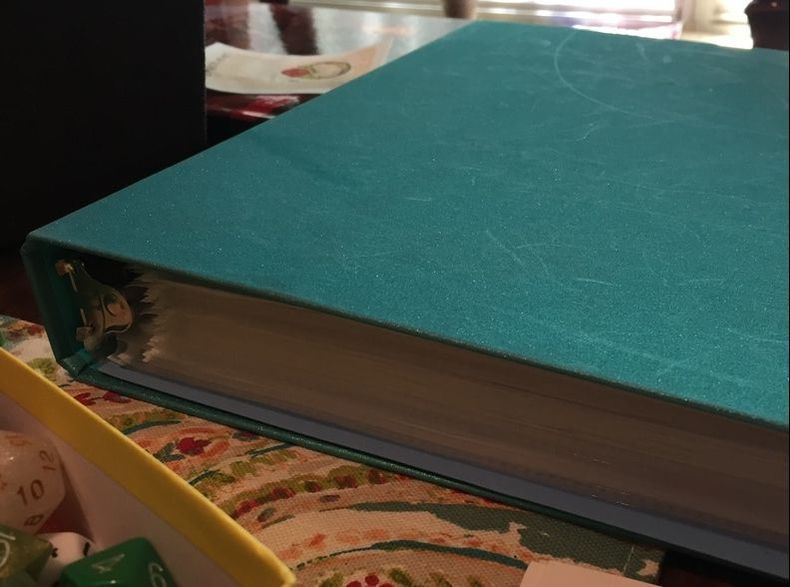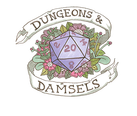Making the Game Your Own |
|
I know that for seasoned players/DMs, having some way to organize your material seems obvious. But this post isn't for seasoned DMs--it's for people who want to start DMing and are unsure how. I started playing D&D less than two years ago. At the age of twenty-seven, I had my very first encounter with RPGs when my boyfriend (let's call him DM Night Shyamalan) invited me to play in the game he DMed. I literally had no experience. None. I can't stress that enough because I need you to understand where I'm coming from and why I think this post is important. So when the day came for me to play and he pulled out this 3-inch binder full of adventures and backstory and world-building and everything else that goes into D&D, I was totally and completely overwhelmed. He'd made all that? He had this giant backstory and lore for this world? How much time had he put into this? How could I ever fit into this world he and his players had built together? That was my first encounter with a DM's binder. It was scary and intimidating and overwhelming. It was part of the reason I thought I'd never, ever be able to DM. And that was very stupid of me. The DM's binder is nothing more than a tool for organization. And organization is the key to (my) DMing. So, let's talk about my binder journey. Getting over the fear. When I started DMing, I had help. A lot of help. Specifically, DM Night basically just told me what to do. Then I did it. One of his first tips was to get myself a binder, and thus began my second encounter with his giant monster binder. ("It doesn't have to be this big," he assured me.) It's a 3-inch, white, completely plain binder that still makes me feel overwhelmed to this day (much like hearing the word Phandalin causes me to have a deep, existential panic). I'm sure it works for him, though, and that is basically the point. He needed a way to stay organized, and by showing me all he had compiled in it, he was showing me I needed to be organized too. So keep that in mind. You don't have to have a binder. You just have to have a way to feel like you're organized and in control. My binder is how do that, so that's what I'm going to show you. Hopefully, it will be less overwhelming. Or, if nothing else, it'll convince you to think of a new, better way to stay organized. Building my binder. First thing you should know: it was once beautiful. It's beauty has faded, and it's now scratched and well-used. Second thing you should know: I spent hours organizing for what is clearly an underwhelming result. I built my binder the same way DM Night built his because that's the only way I knew. I had an area for quests, completed quests, tables, player aides, and character sheets. But after several sessions, it quickly became clear that it wasn't working for me. My maps would get tossed into the same divider as the completed quests, even if the party was staying in the same area, and the tables I built for shops would get tossed in with the random roll tables, despite being tied to specific cities. It was all very confusing. So, after several months, I went back to the drawing board. How my binder is currently organized. Building a better binder forced me to think about how we actually play, which means there was no way I could have just nailed it straight out of the gate. But, knowing what I do know, here is how I've organized my binder. Section 1: Stuff I use every game. There's no rhyme or reason to how this stuff is organized within section one, but it doesn't matter. All of this stuff gets taken out before the start of each game, so I might as well have it all up front. In here you will find:
Section 2: City and Town Information. This is probably the most important section for me. I build a lot of custom shops with custom items and a lot of personality. When I had all of the shops in one section, instead of with their maps, I'd get confused about which town the shop was in. Or have a hard time finding it when I needed it. So now, I have a clear plastic page protector with each town my players have visited. Inside the page protector is a map, any stores and taverns I created for the town, any maps from specific quests that took place in the town, and any NPC character sheets I wrote up for important NPCs. Section 3: Completed Quests. I always print out the adventures to use during the session. After the session, I stick the print out in this section in a clear plastic page protector in case I ever need to reference it. But importantly, if the quest took place in a major town, and I have a map for it, then I do not put that map in this section. I put it with my other maps. For example, if the quest was in the sewers underneath a major town, I would put the map of the sewers with the town map in Section 2. Section 4: Character Creation Information. Here is where I keep a stack of extra character sheets, and information about creating characters. I have things like cheat sheets for ability scores, racial bonuses, and backgrounds. I also have some extra NPCs I can use if I need one. Section 5: Graph Paper, Note Cards, and Extra Supplies. This is just sort of the extra stuff and supplies that I might need while either running a game or planning a game. I usually try to make a battlemap for each session, but if I don't get to it, or we have a surprise random encounter in the woods, it's nice to have some graph paper if necessary. My non-negotiable binder sections.
But your binder should be ever-evolving, just like your game. Will my binder stay the way it currently is forever? Maybe not. Maybe one day I'll start doing a more open world with more pre-planning, and a special section for exploring, random encounters, and available quests will become non-negotiable. But today's not that day. If a binder isn't for you, you still should find a way to organize your game. The session will go a lot better, and you'll be more likely to continue playing in the future if you don't feel overwhelmed at the table, and for me, organization has always been the key to not feeling overwhelmed. You can try file folders or just clear page protectors or whatever system you come up with. I know personally, I'd rather have hard copies of scenarios and notes, but hey, if that's not your scene, there's absolutely nothing wrong with opening up a file folder, naming it "DM's Binder," and calling it a day. Post by Rachel Paxton. She loves her DM Binder more than she has any right to, and where else was she going to talk about it at? You can find her @rachpax.
0 Comments
Your comment will be posted after it is approved.
Leave a Reply. |
AuthorsWe're two D&D obsessed ladies who want to spread our love of the game to women and girls everywhere. Archives
August 2017
Categories
All
|





 RSS Feed
RSS Feed
